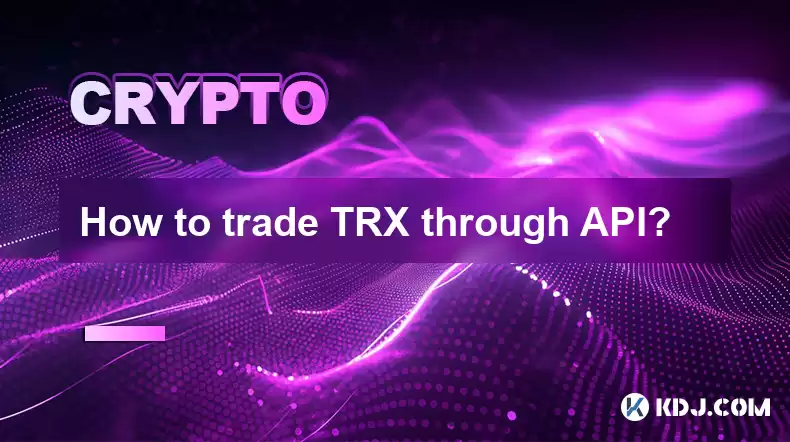-
 bitcoin
bitcoin $87959.907984 USD
1.34% -
 ethereum
ethereum $2920.497338 USD
3.04% -
 tether
tether $0.999775 USD
0.00% -
 xrp
xrp $2.237324 USD
8.12% -
 bnb
bnb $860.243768 USD
0.90% -
 solana
solana $138.089498 USD
5.43% -
 usd-coin
usd-coin $0.999807 USD
0.01% -
 tron
tron $0.272801 USD
-1.53% -
 dogecoin
dogecoin $0.150904 USD
2.96% -
 cardano
cardano $0.421635 USD
1.97% -
 hyperliquid
hyperliquid $32.152445 USD
2.23% -
 bitcoin-cash
bitcoin-cash $533.301069 USD
-1.94% -
 chainlink
chainlink $12.953417 USD
2.68% -
 unus-sed-leo
unus-sed-leo $9.535951 USD
0.73% -
 zcash
zcash $521.483386 USD
-2.87%
How to trade TRX through API?
To trade TRX via API, set up API access on your exchange, choose a programming language, write a trading script, and monitor trades while ensuring security.
Apr 20, 2025 at 02:07 am

Trading TRX (Tron) through an API involves a series of steps that require understanding both the technical aspects of APIs and the specifics of trading cryptocurrencies. This guide will walk you through the process, detailing each step and providing necessary information to ensure you can trade TRX effectively using an API.
Understanding APIs and Their Role in Trading
An API, or Application Programming Interface, is a set of protocols and tools for building software and applications. In the context of cryptocurrency trading, APIs allow traders to interact with exchanges programmatically. This means you can automate trading strategies, execute trades instantly, and retrieve real-time data without manually navigating through the exchange's user interface.
When trading TRX, you'll typically use the API provided by the exchange where you hold your TRX. Exchanges like Binance, Huobi, and OKEx offer robust APIs that support trading TRX. These APIs usually require authentication through API keys, which you'll need to generate and secure carefully.
Setting Up Your API Access
To begin trading TRX through an API, you first need to set up your API access on the chosen exchange. Here's how you can do it:
- Log into your exchange account: Navigate to the API section, usually found under settings or account management.
- Generate an API key: Follow the exchange's instructions to create a new API key. You'll typically need to provide a name for the key and set permissions (e.g., read-only, trading).
- Secure your API key: Once generated, you'll receive an API key and a secret key. Keep these confidential and never share them. It's recommended to use a secure method to store these keys, such as an encrypted file or a secure password manager.
- Enable IP whitelisting: If available, add your IP address to the whitelist to add an extra layer of security.
Choosing a Programming Language and Library
Next, you'll need to choose a programming language and library to interact with the API. Popular choices include Python with the ccxt library, JavaScript with ccxt, or any other language supported by the exchange's API documentation.
- Install the necessary library: For Python, you can use pip to install
ccxtby runningpip install ccxt. - Import the library and set up the exchange: Use the library to connect to your chosen exchange and authenticate using your API keys.
Writing Your Trading Script
With your API access set up and the library installed, you can now write a script to trade TRX. Below is a basic example using Python and ccxt to buy TRX:
import ccxt
Initialize the exchange
exchange = ccxt.binance({
'apiKey': 'YOUR_API_KEY',
'secret': 'YOUR_SECRET_KEY',
})
Fetch the current market data for TRX/USDT
trx_usdt = exchange.fetch_ticker('TRX/USDT')
Place a market buy order for 100 TRX
order = exchange.create_market_buy_order('TRX/USDT', 100)
print(order)
This script fetches the current market data for the TRX/USDT pair and then places a market buy order for 100 TRX. You can modify this script to suit your trading strategy, such as setting stop-losses, take-profits, or implementing more complex trading algorithms.
Executing and Monitoring Trades
Once your script is written, you can execute it to trade TRX. It's crucial to monitor your trades and ensure they are executed as expected. Here's how you can do this:
- Run your script: Execute your script to place trades automatically.
- Monitor your trades: Use the exchange's API to fetch order statuses and check if your trades have been filled. You can also set up notifications to alert you when certain conditions are met.
- Adjust your strategy: Based on the performance of your trades, you may need to adjust your strategy or script to optimize results.
Managing Risks and Security
Trading through an API introduces additional risks, particularly related to security. Here are some best practices to manage these risks:
- Use two-factor authentication (2FA): Enable 2FA on your exchange account to add an extra layer of security.
- Limit API key permissions: Only grant the necessary permissions to your API key. For example, if you're only using the key for trading, don't enable withdrawal permissions.
- Regularly review and revoke API keys: Periodically check your API keys and revoke any that are no longer in use.
- Implement error handling and logging: In your scripts, use error handling to manage unexpected issues and log all actions for auditing purposes.
Integrating with Other Tools
To enhance your TRX trading strategy, you might want to integrate your API trading with other tools and services. For example:
- Data analysis tools: Use tools like TradingView or custom scripts to analyze market data and generate trading signals.
- Portfolio management: Integrate with portfolio management tools to track your TRX holdings and performance across different exchanges.
- Automated trading platforms: Consider using platforms like 3Commas or Cryptohopper, which offer pre-built trading bots and can interact with exchange APIs.
Frequently Asked Questions
Q: Can I use the same API key for multiple exchanges?A: No, each exchange requires its own unique API key. Using the same key across multiple exchanges is not possible and would be a security risk.
Q: How often should I update my API keys?A: It's good practice to update your API keys periodically, such as every few months, to maintain security. If you suspect any compromise, update them immediately.
Q: What are the common errors when trading TRX through an API?A: Common errors include authentication failures, insufficient funds, network issues, and rate limiting. Always implement robust error handling in your scripts to manage these issues.
Q: Can I automate TRX staking through an API?A: While some exchanges offer staking services, not all support API access for staking. Check with your exchange to see if they allow staking automation through their API.
Disclaimer:info@kdj.com
The information provided is not trading advice. kdj.com does not assume any responsibility for any investments made based on the information provided in this article. Cryptocurrencies are highly volatile and it is highly recommended that you invest with caution after thorough research!
If you believe that the content used on this website infringes your copyright, please contact us immediately (info@kdj.com) and we will delete it promptly.
- Bitcoin's Bear Market Blues: A Data Dive into the Crypto Winter Forecast
- 2025-12-26 12:35:01
- Ampleforth's FORTH Token Drives Decentralized Governance: A Deep Dive into Community-Led Evolution
- 2025-12-26 13:15:01
- Maple Finance Hits New Heights: Record $500 Million Loan Issuance Drives SYRUP Token Surge
- 2025-12-26 07:30:02
- Bitcoin Options Expiration Sparks Trader Speculation: A Deep Dive into Market Dynamics
- 2025-12-26 07:30:02
- Bitcoin, Altcoin, and Investment: Navigating the Evolving Crypto Landscape in 2026
- 2025-12-26 07:10:01
- Binance Launchpad's Soaring ROI: A HODLer's Conundrum in the Crypto Jungle
- 2025-12-26 06:45:01
Related knowledge

The Ultimate Guide to Navigating Your First Crypto Bull Run
Dec 04,2025 at 02:00pm
Understanding the Crypto Bull Run Cycle1. A bull run in the cryptocurrency market is characterized by a sustained increase in asset prices, often driv...

An Investor's Primer on Bitcoin and Digital Assets
Dec 05,2025 at 07:59pm
Understanding Bitcoin and Its Role in Modern Finance1. Bitcoin emerged in 2009 as the first decentralized digital currency, operating on a peer-to-pee...

The Definitive Guide to Cryptocurrency for Beginners in 2025
Dec 11,2025 at 12:00pm
Understanding the Basics of Cryptocurrency1. Cryptocurrency is a form of digital or virtual currency that relies on cryptography for security and oper...

Everything You Need to Know About Crypto Before Investing
Dec 09,2025 at 04:19pm
Understanding the Basics of Cryptocurrency1. Cryptocurrency is a digital or virtual form of currency that uses cryptography for security and operates ...

The Ultimate Guide to Your First Year in Crypto
Dec 17,2025 at 10:00pm
Your First Steps into the Crypto World1. Entering the cryptocurrency space begins with understanding the foundational concept: blockchain technology. ...

A Simple, No-Nonsense Guide to Cryptocurrency
Dec 18,2025 at 02:40pm
What Is Cryptocurrency?1. Cryptocurrency is a digital or virtual form of money that uses cryptography for security and operates independently of a cen...

The Ultimate Guide to Navigating Your First Crypto Bull Run
Dec 04,2025 at 02:00pm
Understanding the Crypto Bull Run Cycle1. A bull run in the cryptocurrency market is characterized by a sustained increase in asset prices, often driv...

An Investor's Primer on Bitcoin and Digital Assets
Dec 05,2025 at 07:59pm
Understanding Bitcoin and Its Role in Modern Finance1. Bitcoin emerged in 2009 as the first decentralized digital currency, operating on a peer-to-pee...

The Definitive Guide to Cryptocurrency for Beginners in 2025
Dec 11,2025 at 12:00pm
Understanding the Basics of Cryptocurrency1. Cryptocurrency is a form of digital or virtual currency that relies on cryptography for security and oper...

Everything You Need to Know About Crypto Before Investing
Dec 09,2025 at 04:19pm
Understanding the Basics of Cryptocurrency1. Cryptocurrency is a digital or virtual form of currency that uses cryptography for security and operates ...

The Ultimate Guide to Your First Year in Crypto
Dec 17,2025 at 10:00pm
Your First Steps into the Crypto World1. Entering the cryptocurrency space begins with understanding the foundational concept: blockchain technology. ...

A Simple, No-Nonsense Guide to Cryptocurrency
Dec 18,2025 at 02:40pm
What Is Cryptocurrency?1. Cryptocurrency is a digital or virtual form of money that uses cryptography for security and operates independently of a cen...
See all articles









































































